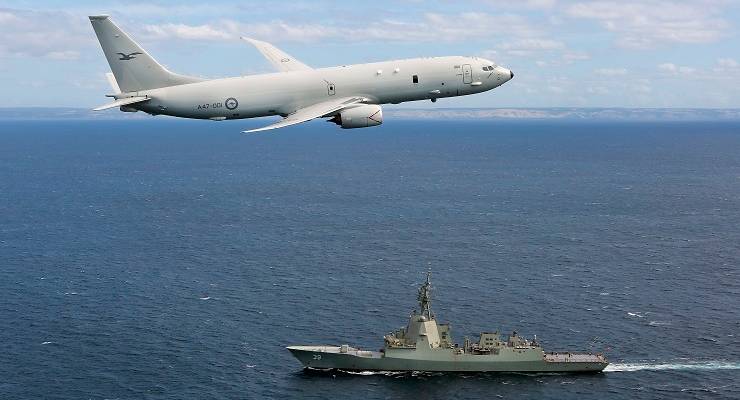
As Crikey reported earlier this week, when Australian ships and aircraft operate in the South China Sea, they’re not simply exercising freedom of navigation through the waters of China’s exclusive economic zone (EEZ). They are engaging in military espionage.
Here’s exactly what they are doing.
Our vessels drop hydrophones (microphones designed to operate underwater) mounted on a flotation device (a buoy). The buoy also carries a radio transmitter that transmits sounds detected by the hydrophone to an aircraft.
What gets detected?
- Acoustic noise from a submarine’s turbines, propellers and other machinery
- Water flow over the hull of a vessel once it goes above 10 knots
- Propeller cavitation, which occurs when a high propeller speed creates bubbles in the water
- Noises by the crew inside the submarine.
Each ship or submarine has an acoustic signature akin to a sonic fingerprint, which we use for identification purposes. We do this by comparing the signal collected by our sonobuoys with a previously recorded signature — remembering acoustic signals are affected by changes in water temperature, variations in depth and salinity and the nature of the seabed — and a vessel’s acoustic signature changes when its load changes, not to mention changes due to age, wear and tear, and modifications.
The library of signatures we’ve compiled enable vessel classification, identification, activities and capability. We do surveillance to record and update vessels’ acoustic signatures every six months or so.
Obviously these are all aimed at the People’s Liberation Army Navy. The US has also built a network of undersea and overhead sensors at choke points near China’s coastline, allowing it to monitor Chinese ballistic-missile submarines as they try to gain access to the open ocean.
The goal is to enable US hunter-killer submarines to trail them and sink them at the outbreak of hostilities, eliminating China’s nuclear deterrent (which is relatively small by US standards). One consequence is that China thus has an incentive to launch first if it believes an attack is imminent.
Remember, the US and Australia take the view that they’re allowed to do this within China’s exclusive economic zone — a view not shared by friendly countries like India, Indonesia and the Philippines. Malaysia, Vietnam, Brazil and Argentina don’t share it either. They take the view that warships have “no automatic right of innocent passage in their territorial seas”.
This intelligence-gathering is clearly integral to US and Australian planning for the possibility of conflict with China. The Chinese government — reflecting its view that if Western countries are going to conduct such activity within its EEZ, it will do the same — undertakes the same activities.
The problem lies with the lack of transparency and the reliance on the charade of “freedom of navigation” by the government. Our vessels and aircraft are there so that the US can more effectively destroy Chinese vessels as quickly as possible at the start of any conflict. This should be made clear to voters every time there’s an incident involving Chinese vessels or aircraft — along with the fact that regional allies take a different view from us.
Many voters may be entirely relaxed about that — but they’re not being told.
This is not to be conflated with China’s aggressive behaviour in the South China Sea, and its rejection of international rulings. It’s about whether our government — aided by security think tanks and much of the media — is prepared to mislead Australians about what our sailors and aircrew are doing far from home.









I do not see how our national interests are served in any way by joining in the coming US war upon China. By allowing our military to participate in these aggressive operations we are painting a target on our heads, and on the heads of our children – for no possible benefit.
It is thus no wonder why the Chinese Government will not lift its current Trade sanctions against Australia
The reason for those sanctions is that Australia’s prime minister was a tool.
It’s not primarily a shooting war.
Like the Cold War that followed WEII it’s an economic contest. WWII weakened the colonial powers Britain, France, Belgium, Holland, Portugal, Spain and Germany.
The US, relatively untaxed by war, swooped in to establish economic hegemony through a new form of colonialism effected by the United Nations, World Bank, IMF.
Crucially, the CIA, performed covert ops with tens of billions of $ in funding to snuff out emerging democratic movements in resource rich African, Latin American, and Papuan nations.
We all knew this to be the case but it is good to see someone in the media finally admit it.
As to FONOPS, they are complete BS
https://johnmenadue.com/the-u-s-china-dispute-over-the-taiwan-straits-legal-regime/
Frank and open discussion on policy is essential. Breaking international conventions with big brother is dangerous and the implications of war strikes at our very existence.
It is not a right/left matter – in my opinion we should stick strictly to international conventions and return to our status as a good international citizen; poking China with a stick is just plain stupid.
Great to learn we keep planes and air crew based in the Phillipines to conduct “freedom of navigation” exercises. The cost? Perhaps the ABC’s tame crew of defence-fanboys (eg Stan Grant, Andrew Greene) might enquire.
From what I know the China position on Taiwan has not changed for decades. It prefers the status quo as existing since the 1970’s. It’s the US helped by allies that are trying to change the status quo in order to provoke Chinese aggressive retaliation. And Australia is complicit in this warmongering. BTW although we all know China has bases on the disputed Islands in the SCS, so have Vietnam, Taiwan and the Philippines as well but that is conveniently rarely mentioned. Anyone who has a modicum of geo political knowledge knows the Chinese bases are there to protect its sea lanes. The majority of shipping travelling through the SCS is bound for or leaving China. So it is in China’s interests and wishes to keep them free, open and peaceful. US strategy on the other hand is to manufacture conflict so as close them at their time of choosing.
China is well on it’s way to being the dominant financial and military power. Am I losing sleep that a bunch of allies are working to put military checks on their power. Nope.
Does it prevent China going about its legitimate business, nope.
Do I want another manufactured war in the middle east, nope…. well, that depends who else is manufacturing a war to get their hands on the ME oil.
China has stated public it will take Taiwan back, by force if necessary.
https://www.reuters.com/article/us-china-taiwan-idUSKCN1OW04K
Wanting status quo? Ease up on the coolaid!
It’s not a threat, simply a statement of fact. China’s preference is to peacefully reunite but they will not rule out force if Taiwan is stupid enough to declare independence. Nothing more than a continuation of the Chinese Civil War which the Kuomintang lost in 1949 (and fled to Taiwan with everything of value that wasn’t nailed down).
Taiwan is therefore a rogue province and consequently it is an internal Chinese matter and nothing to do with any other country.
I didnt catch your thoughts on Russian behavior in Ukraine. Do you see Russia as a belligerent, aggressive invading force?
How many times do I have to tell you to watch some Professor John Mearsheimer lectures? I agree with his long standing position.
“According to John Mearsheimer, one of America’s leading foreign-policy thinkers, Washington will not let China become the dominant military power in the region without putting up a serious fight. In these circumstances, it’s naïve to think that Australia can sit on the sidelines and get the best of both worlds: unconstrained trade with China while keeping the U.S. security umbrella over its head. Canberra must support Uncle Sam ”
https://bellschool.anu.edu.au/news-events/events/6964/china-debate-john-mearsheimer-vs-hugh-white
Mearsheimer doesnt seem to share your fondness for China and dislike of the US. He sees China as a danger that needs to be constrained and counter balanced.
There are two schools of thought in the US elite on dealing with Russia and China. One favoured by Trump and Mearsheimer favours making friends with Putin and Russia to surround China and weaken the EU. The other favoured by Biden and Liberals is to weaken Russia and install regime change to favour the US, weaken the EU and to surround China. The way the Ukraine situation is turning out won’t please Mearsheimer and won’t please Biden either. Russia/China relations are now stronger than ever. The biggest loser will be the EU
And eventually China will probably go Russian for Siberia. Not now. Not anytime soon, but in 50 years maybe. That’s one of the reasons Russia needs Ukraine. It needs the man power, the resources and the economy all in its orbit …in case China tries to expand northward.
Every country would prefer to achieve its foreign policy goals without the use of military force. That proves nothing. China has stated it will use force if it needs to. Clearly their ploy is to play the long game to get Taiwan into a position where it has no choice. That day is coming.
Clearly the US wants Taiwan as a beach head in the event of war. I can fully understand why that pisces off the Chinese. The US and allies arent in it for the kinship of the Taiwanese.
History tells us that one country prefers to achieve its foreign policy goals with the use of military force. Guess which one. You know, the one with 800 military bases on other people’s territory. The one that has invaded or bombed scores of nations since 1945. The same one that spends more on weapons that the next five nations combined. The one that has just ‘pivoted (its war machine) to Asia’ while at the same time lecturing China about not militarising the IndoPacific region.